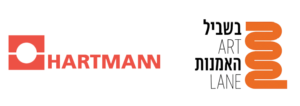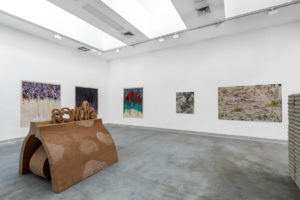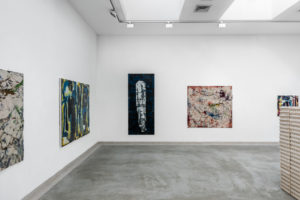Layer operation – September 2020
Gilad Efrat, Yitzhak Golombek, Jonathan Hirschfeld, Orly Maiberg, Rona Perlman
Essentially, Kupferman was a “laborer-painter” who did not wait for inspiration or for the “right moment”, but made his way to the studio every day, prepared to labor, to paint. The exhibition Layer Action traces the Kupfermanian artistic craft, its essence and characteristics, as intertwined in the works of the participating artists. Kupferman’s craftsman presence emerges from these artists’ works, who share his conception of time and the artistic action.
Kupferman’s painting act would often begin with ritualistic actions, starting with covering the substrate with an intense green paint, followed by straight, sharp, confident lines that form a sort of grid. Perhaps under the influence of his work as a scaffolder, the grid was for Kupferman the basis for the multiple layers accumulating above it. A basis in the sense of physical foundation, but also in the formal-metaphorical sense: “The horizontal lines are like horizons – different viewpoints on reality – and the vertical lines are like human presences”.
Next, the painting act becomes somewhat loosened, dispersed in the footsteps of the events on the painterly surface – sometimes stopping and tracing back it steps, and sometimes starting a new chapter. The cumulative layers detail the history of their creation, of the inner dialogue between the artist and his response to the “painting’s requests”. This is a process that shifts from movement through suspension to observation, after which the need arises to scrape off, cover up, peel off, seal and cover again. “I’m not a man of great decisions. I never predetermine the painting. I advance by placing one thing next to the other and one above the other as well”.
Beyond all the actions taking place in the duration of the creative work, time is omnipresent. That time which dictates the duration of drying, time for thoughts, memories and new frames of mind. All those intermingle and accrue into acceptance of what is done or into regret and the formation of an additional layer that blurs all that which has already happened on the canvas. Time is what decides the Kupfermanian creative process. Coping with it and cutting the painting action short are perhaps the essence of the entire process. Or as he put it, “In my painting there is no subject, or more precisely, the subject is the time of producing the painting”.
Time is also key to the abstract works of Gilad Efrat. Like Kupferman, Efrat piles paint layers, sometimes “used” and recycled from other works, removing, exposing and sealing them. The drying process, which for Kupferman dictates time for thought, is the duration Efrat struggles against in order to perform his painterly expression, justify it before the material hardens permanently, completely concentrated on the present moment, on the now that unfolds on the canvas. Efrat identifies with the Kupfermanian work ethics, and seeks in the routine of the quotidian painting practice freedom and evolution, the next action that will allow him to “Retell the whole story each time anew, and yet be able to move on”.
The multilayered substrate used by Jonathan Hirschfeld represents a highly intensive scene. The “vertical power” and grey-purplish colorfulness identified with Kupferman are also present in his paintings. Sometimes, the gridlines seem like a foundation carrying the painting event on its back, and sometimes they are loose, marking their liquid path over the surface. As a “storyteller-painter”, Hirschfeld combines mythology and sketches that range between the figurative and abstract, raising issues of social ethics, criticism and personal biography, while Kupferman carries his personal memory and history within him without being exposed – a seemingly narrative-free history.
According to Hirschfeld, Kupferman affected his work from the aspect of belief in painting, in the abstract, in the modern sentiment that preceded the humor, parody, reference and pastiche of our times. His works in the exhibition are part of the series Judgment, inspired by Michelangelo’s “The Last Judgment”, where “the tormented and deep purple gives the apocalyptic horror a heavy undertone, like bass playing next to the melody”.
Orly Maiberg’s pieces call for multilayered observation. They shift between a minor narrative and unsystematic randomness, out of which emerge allusions of disrupted landscapes. “Order comes out of chaos”, as Kupferman puts it. As a first step in her work, she immerses the canvas in ink paints, which form liquid topographic textures. Using pieces of cloth, she covers parts of the painting to create a gentle, unraveled layeredness, almost the opposite of Kupferman’s sharp and decisive hand movement.
The relation to Kupferman’s work is expressed, according to Maiberg, in her own essence as a “laborer-painter”. For her, it is the studio – the worksite – that motivates the processes and transformations in the painting. Hers is a musical move: one action drags another or a suspension, which takes shape as the “empty” part of the painting.
The image of the grid and its deconstruction is present in Rona Perlman’s works. Sometimes, the constructed motif precedes the deconstructed one, and sometimes it is only at the final stage of the painting action that she “calls it to order” and reorganized that which has been disordered. Kupferman’s oeuvre first infiltrated her consciousness as a painter intuitively. Later on, having delved deeper into it, Kupferman’s heritage gradually became a major source of inspiration. Many of her works are performed over layers of past drawings, which have become a memory encapsulated in the emerging painting, and with it the wondering, when is something valuable created, enough to make her stop.
Yitzhak Golombek’s site-specific installation “Egg Carton Cube”, which is at the center of the exhibition space, adds an aspect of architecture and memory to the dialogue with the Kupfermanian action. The large cardboard structure made up of layers upon layers of egg cartons reflects ephemerality, action and duration, stacked into a three-dimensional grid. In “Cow”, Golombek, like Kupferman, examines the nature of the artist’s autograph, turning it into a presence in its own right, part of the artistic expression and identity.
The works in the exhibition reveal a move that is shared by all artists – a reflection on the very action of making art – calling upon the viewers to observe them in the spirit of Kupferman’s words: “Something is as it is, just as it is not: it is always a mere hint, an open road ”.
Tal Bechler
1 Moshe Kupferman in a conversation with Stuart Klawans at Kibbutz Lohamei HaGeta’ot, March 1995.
2 Quoted in “Israel Prize Laureates in 2000, Ministry of Education website (Hebrew).
3 Conversation with Stuart Klawans.
4 Gilad Efrat in a conversation with Tal Bechler.
5 Jonathan Hirschfeld in a conversation with Tal Bechler.
6 Conversation with Stuart Klawans
7 Jürgen Harten, “Cryptic, Rather, Time and Again”, Quoted in Yona Fischer (ed.), Moshe Kupferman, Works from 1962 to 2000. Israel Museum, 2002, p. 333 (English).



